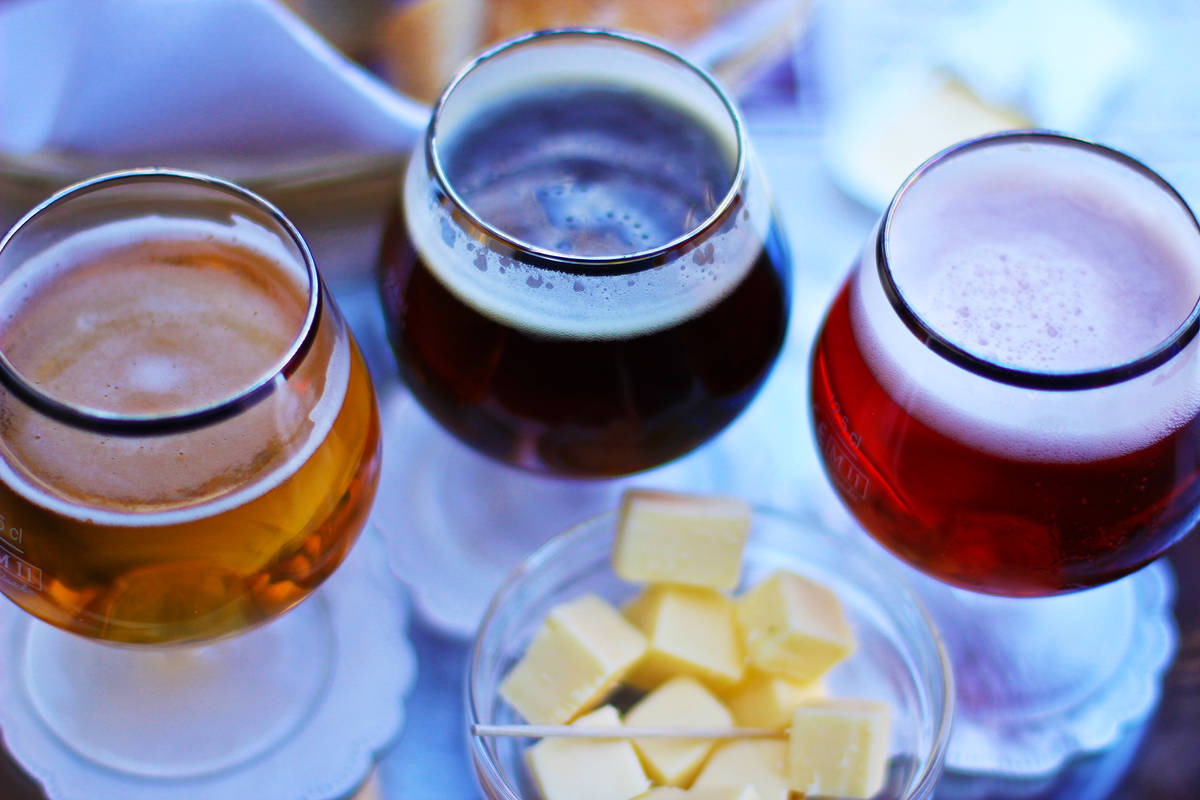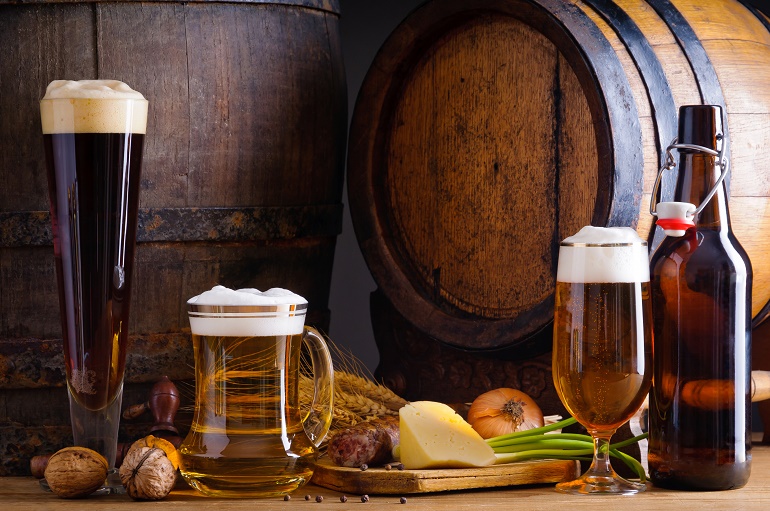Start 14-Day Trial Subscription
*No credit card required

Beer & Cheese Pairing Guide
When it comes to pairing beer with cheese, the start of any conversation typically begins with an oft-repeated line. The two make for a natural match, it is said, since they were raised together on the farm, with the grain that goes into making the beer also being used to feed the milk-producing cow, sheep or goat. It’s a nice idea and one not without merit. But the intricacies of blending beer and cheese to perfection go way beyond a snappy sound bite.
The world of cheese, like that of beer, is constantly evolving, as new producers arrive and test the bounds of traditional craft. These days there are innumerable options for pairing beer with cheese – long the upscale domain of wine – and while some can find it fairly intimidating to sift through the wide array of possible matches, a few basic ground rules will put you well on your way to blissful blending.
Here in America, the growing craft beer and artisanal cheese movements share a great deal of common ground. The creativity, passion and experimentation that continues to draw legions of fans to craft beers can also be found in the many specialty creameries that have popped up around the country as of late.
A number of producers, like Rogue Ales and the Rogue Creamery in Oregon, which despite their names are not affiliated, have embraced this common ethos and turned it to their advantage. The creamery uses Rogue’s Chocolate Stout and its Morimoto Soba Ale in making two of its cheddars, and the pair’s other tremendously popular beers and cheeses – the creamery’s Rogue River Blue was awarded the top prize at the 2009 American Cheese Society awards in Austin, Texas – have socialized often in recent years at beer dinners and other events. Indeed, it seems that lately everywhere you look beer and cheese are sharing the spotlight.

These days there are innumerable options for pairing beer with cheese – long the upscale domain of wine – and while some can find it fairly intimidating to sift through the wide array of possible matches, a few basic ground rules will put you well on your way to blissful blending. Photo Credit: Flickr/Michela Simoncini
The growing association of good beer and good cheese is not lost on the Artisanal Premium Cheese Center in New York City, whose Dean of Curriculum, Max McCalman, is known as one of America’s foremost experts on cheese. The cheese center, a wholesale and retail operation that also holds classes on the many facets of cheese production and tasting, offers a collection of cheeses intended for certain beers, with descriptions written by McCalman. He is the co-author of three standout books on the world of cheese, including the recently released “Mastering Cheese: Lessons for Connoisseurship from a Maître Fromager,” which has a chapter dedicated to beer and cheese. You would be hard pressed to find a better adviser to help get you started combining the two.
“I loved cheese all my life,” he said when reached by phone recently. McCalman was born in Louisville, Kentucky, and studied psychology at Hendrix College in Arkansas, but his true passion long revolved around the nightly ballet of restaurant work. He remembered thinking, “this is a fine art practically, to see a restaurant run like a well-oiled machine, with all the moving parts and all the challenges.” Already somewhat of a wine expert, McCalman settled into a role overseeing wine programs for hotel companies, their individual properties and some freestanding restaurants. But cheese was constantly calling – it is “a better niche for me,” he said – and so he set about looking for a way to leave wine behind and focus his attention on it.
That opportunity came in 1995, when McCalman joined the well-known chef Terrance Brennan to devise a cheese program for Brennan’s stellar New York restaurant, Picholine. The response was emphatic, so the partnership continued when Brennan decided to open Artisanal Fromagerie, Bistro & Wine Bar, also in New York, which won rave reviews for its thoroughly pungent, cheese-obsessed atmosphere.
Next up was the Artisanal Premium Cheese Center itself, started in early 2003 as an offshoot of the restaurants. McCalman helped establish the center as an affinage capital that remains unparalleled in America, its five caves specifically designed to age goat, blue, washed rind, bloomy rind and tome types. In 2007 the center was bought by American Home Food Products Inc. In addition to the online and wholesale business and classes, some of which are taught by McCalman himself, it is now wholly independent but continues to supply restaurants around the country, including Picholine and Artisanal.
As the center’s self-described “brand ambassador,” McCalman spends a good bit of time these days attending events and moderating panels on the fast-growing American cheese market. “Right here in the United States,” he said, “what’s happening in cheese making is just mind-boggling to see. The per capita consumption of cheese has tripled since 1970. But I think it’s not just eating more cheese, I think it’s eating better cheese, too.”
And increasingly, this cheese boom is overlapping with the similar rise in good beer. Even the big brands are looking for an expert, McCalman said, noting that he had recently heard from The Boston Beer Company, producers of Samuel Adams and now the largest American-owned brewery. They were “rolling out a new line of beers and they want to have some cheese recommendations to go with the beers,” he said.

"The per capita consumption of cheese in the U.S. has tripled since 1970, McCalman said. "But I think it’s not just eating more cheese, I think it’s eating better cheese, too.”
As one would expect from his wine background, McCalman mingles his love of beer and cheese with a rather democratic approach to pairing. “I also enjoy my whiskeys, I enjoy sakes,” he said. “I am always looking for the harmony, the balance that cheeses and their beverage partners offer.
“Any hook that I can give to get cheese into people’s mouths, if they are beer drinkers or wine drinkers or spirits drinkers or whatever, then I think that can make for an interesting medley.” Still, he is quick to boast of beer’s advantages when it comes to cheese pairing. In beers, he sees “a different kind of relationship than wines have.
“I find that it’s more about balance and less about harmony, beers being a little less acid than wines.” When pairing wine with food, especially cheese, the main goal is often to keep the tastes from fighting or overwhelming each other. But beer, with its wide variety of styles, often has the ability to stand up to the rich flavors of cheese, melding naturally as the two even each other out. Take, for instance, a common pairing like a classic Irish dry stout with a sharp cheddar. “That’s a good starting point right there,” McCalman noted. He suggests avoiding the more waxy and plastic-like grocery-store types of cheddar “if you really want to have the thrills,” and trying something more along the lines of a “farmhouse, raw milk, cloth-bound cheddar that’s toothsome.” That type of cheese “has some acidity but it doesn’t rely upon its acid only, it has a nice balanced finish to it,” making it a superb companion to the smooth, roasted malt taste of the dry stout.
As for a sweet stout with a much heavier, chocolaty flavor, McCalman suggests pairing it with a buttery triple crème cheese. Together, he notes, the two produce an effect not unlike that of ice cream with chocolate drizzled on top. “Some of the best matches for beers,” he continued, “are cheeses that have balance in their flavor profiles, and it’s offset with a good texture, too,” texture being one of beer’s chief advantages over wine.
“That effervescence that beer has is a great foil” for cheese, McCalman said, “because those bubbles can lift up the acids and the fats left behind on the tongue delightfully.” In addition to triple crèmes, McCalman noted that he especially appreciates the ways in which some beers collaborate with other soft-ripened cheeses, like the washed-rind, stinky cheeses – Époisses or Taleggio, for instance. With those you should look for a lighter beer like a wheat or a lager such as a pilsner, he said.
Despite the common origins of beer and cheese going back to the grain, the concept of terroir – that agricultural products have intrinsic characteristics based on where they are grown – does not really hold up when it comes to pairing the two, according to McCalman. “By the time you get to the final product of the beer or the cheese,” he said, “I mean there’s so much going on in that that it’s less about the soil.”

“That effervescence that beer has is a great foil” for cheese, McCalman said, “because those bubbles can lift up the acids and the fats left behind on the tongue delightfully.” Photo Credit: Flickr/Christer Edvartsen
Still, he mentions that “terroir as far as personality goes, of what shapes potential partners, has some bearing.” Dutch Goudas do pair well with Dutch beers, he notes, and in other beer-centric places like Germany, certain types of cheeses have been created to blend well with the local brews. Of course cheese and beer share a great deal in Belgium as well, with a number of farmhouse breweries and Trappist abbeys producing both, including Chimay, which started making cheese in 1876.
Like many American beer drinkers these days, McCalman is particularly fond of India Pale Ales, hoppy brews that burst with floral and citrus notes. He tends to pair the style with a British Stilton, a veiny cow’s milk blue cheese whose bold flavor plays nicely off the bitter bite of the hops, but also recommends trying an aged Gouda, washed-rind cow’s milk cheeses or farmhouse cheddars. Another excellent match McCalman suggests trying is Pleasant Ridge Reserve from the well-known Uplands Cheese Company in Dodgeville, Wisconsin, a firm, raw cow’s milk creation similar to French alpine cheeses that he calls “one of the best cheeses made in the United States,” with a pale ale, specifically, he said, that of New York’s Ithaca Beer Company, which is brewed with Cascade, Willamette and Centennial hops. Pale ales like Ithaca’s also go well with goat and firm sheep’s milk cheeses, he added.
So there you go. Next time you’re hosting a dinner party, try avoiding the seemingly requisite wine and make room for beer next to your cheese plate. Your guests – and your palate – will thank you for it.
Hungry yet?
There are plenty of options for trying these sorts of top-notch beer and cheese pairings.
The Artisanal Premium Cheese Center (500 West 37th Street, New York, N.Y.; 877-797-1200; www.artisanalcheese.com) sells an assortment of cheeses selected specifically to go with certain craft beers for $69 plus shipping. Additional pairing suggestions can be found on the center’s Web site.
If you’re in New York, make time to visit Artisanal Fromagerie, Bistro & Wine Bar (2 Park Avenue, 212-725-8585;www.artisanalbistro.com), Picholine (35 West 64th Street, 212-724-8585; www.picholinenyc.com), or the more casual Bar Artisanal (268 West Broadway, 212-925-1600;www.barartisanal.com), which opened last spring. And as of September, there are also now two Artisanal culinary outposts near Seattle (www.artisanalwa.com).
All of the restaurants’ cheeses come straight from the center’s caves, and most of them offer a wide selection of craft beers for pairing.
Max McCalman’s third book,“Mastering Cheese: Lessons for Connoisseurship from a Maître Fromager,” went on sale in November.
More information is available atwww.maxmccalman.com.
MORE FROM THE MASTER
Pairing suggestions from Max McCalman
1. Smokey Oregon Blue cheese (Rogue Creamery, Oregon)
Captain Lawrence Brewing Company’s Captain’s Reserve Imperial I.P.A.
2. Gruyère hard cow’s milk cheese (Switzerland)
Ithaca Beer Company’s Pale Ale
3. Kuntener reblochon-style cheese (Switzerland)
KleinBrouwerij De Glazen Toren’s Jan de Lichte
4. Barely Buzzed espresso and lavender-rubbed cheese (Beehive Dairy, Utah)
Rogue Ales’s Dead Guy Ale
5. Pecorino Toscano Stagionato firm sheep’s milk cheese (Italy)
Brewery Ommegang’s Rare Vos
6. Abbaye de Tamié semi-soft cow’s milk cheese (France)
Brouwerij Duvel Moortgat’s Maredsous 8 Dubbel
7. Manchester aged semi-soft goat’s milk cheese (Consider Bardwell Dairy, Vermont)
Bayerischer Bahnhof’s Berliner-style Weisse
8. Azeitão soft sheep’s milk cheese (Portugal)
Dogfish Head’s Golden Era
9. Piper’s Pyramid soft goat’s milk cheese (Capriole Farms, Indiana)
Greenpoint Beerworks’s Kelso Hop Lager



